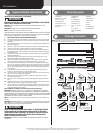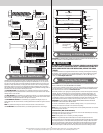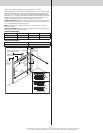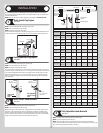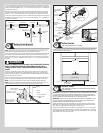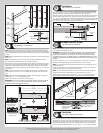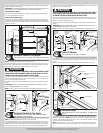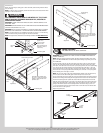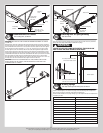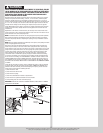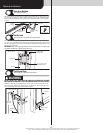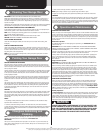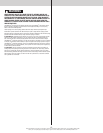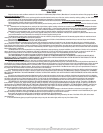
Please Do Not Return This Product To The Store. Contact your local Wayne-Dalton dealer. To find your local Wayne-Dalton dealer,
refer to your local yellow pages business listings or go to the Find a Dealer section online at www.Wayne-Dalton.com
WARNING WARNING
PRIOR TO WINDING OR MAKING ADJUSTMENTS TO THE SPRINGS, ENSURE
YOU’RE WINDING IN THE PROPER DIRECTION AS STATED IN THESE INSTAL-
LATION INSTRUCTIONS. OTHERWISE THE SPRING FITTINGS MAY RELEASE
FROM SPRING IF NOT WOUND IN THE PROPER DIRECTION AND COULD
RESULT IN SEVERE OR FATAL INJURY.
Alternately inserting the winding rods into the holes of the springs winding cone, rotate the
winding cone upward toward the ceiling, as shown, 1/4 turn at a time, until the required
number of complete turns for your door height is achieved. As the last 1/8 to 1/4 turn is
achieved, securely hold the winding rod while tightening both set screws in the winding cone
to 14-15 ft. lbs. of torque (once set screws contact the shaft, tighten screws one full turn).
Carefully remove winding rod from winding cone. Repeat same process for the opposite
spring. While holding the door down to prevent it from raising unexpectedly in the event the
spring(s) were over-wound, carefully remove the locking pliers from the torsion tube and
vertical tracks.
Adjustments to the number of turns stated may be necessary. If door rises off floor under
spring tension alone, reduce spring tension until door rests on the floor. If the door is hard to
rise or drifts down on its own, add spring tension.
NOTE: An unbalanced door such as this can cause garage door opener operation problems.
Now, permanently attach the weatherstrips on both door jambs and header. The weather-
strips were temporarily attached in Preparing the Opening, in the pre-installation section of
this manual.
NOTE: When permanently attaching the weatherstrips to the jambs, avoid pushing the weath-
erstrips too tightly against the face of door.
Now, lift door and check its balance. Adjustments to the required number of spring turns
stated may be necessary. If door rises off floor under spring tension alone, reduce spring
tension until door rests on the floor. If the door is hard to raise or drifts down on its own, add
spring tension. A poorly balanced door can cause garage door operator operation problems.
To adjust spring tension, fully close door. Apply vice grips to track above third track roller.
Insert a winding rod into the winding cone. On single spring doors, counterbalance lift
cable tension must be maintained by placing vice grips on torsion shaft before loosening
set screws in the winding cone. Push upward on the winding rod while carefully loosening
the set screws in the winding cone. BE PREPARED TO SUPPORT THE FULL FORCE OF THE
TORSION SPRING ONCE THE SET SCREWS ARE LOOSE. Carefully adjust spring tension 1/4
turn. Retighten both set screws in the winding cone and repeat for the other side. Recheck
door balance DO NOT ADJUST MORE THAN 1/2 TURN FROM THE RECOMMENDED NUMBER
OF TURNS.
If door still does not balance correctly, contact a qualified door agency. If the door still does
not operate easily, lower the door into the closed position, UNWIND THE SPRING(S) FULLY
(Reference the insert “Removing The Old Door/Preparing The Opening” section on torsion
spring removal), and recheck the following the items:
1.) Check the door for level.
2.) Check the torsion shaft for level.
3.) Check the track spacing.
4.) Check the counterbalance lift cables for equal tension.
5.) Check the track for potential obstruction of the track rollers.
6.) Clamp locking pliers onto track and rewind springs.
IMPORTANT: IF DOOR STILL DOES NOT OPERATE PROPERLY, THEN CONTACT A TRAINED
DOOR SYSTEM TECHNICIAN.
Torsion
shaft
Winding cone
Spring
Approved
winding rods
Set screws
Approved
winding rods
Winding cone
Typical center
bearing bracket
Spring
Winding cone
12



